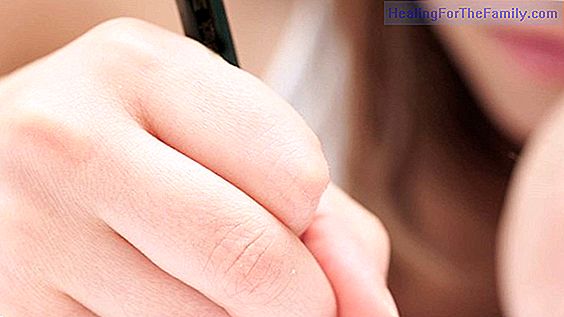38 Weeks of pregnancy
In the week 38 of pregnancy you must be very attentive to labor contractions. The uterus is no longer the indispensable environment the baby needs because he already has all his organs ready to survive on the outside. Some continue their development after birth, such as the nervous system, but the b
In the week 38 of pregnancy you must be very attentive to labor contractions. The uterus is no longer the indispensable environment the baby needs because he already has all his organs ready to survive on the outside. Some continue their development after birth, such as the nervous system, but the baby is already able to live normally outside the womb.
With theweek 38 of pregnancythe countdown begins until the goal of pregnancy week to week, which is the moment of delivery. Statistics reveal that only 5 percent of babies are born on the scheduled date, while the remaining 95 percent do so sooner or later.
Changes in the body after 38 weeks of pregnancy

Predicting the day when the baby will be born with accuracy is complicated, therefore, it is advisable to be alert to signs that you are in labor such as water breakage, regular contractions or vaginal bleeding
There are several factors that unite to trigger labor as of the thirty-eighth week of pregnancy. The baby's lungs and the placenta are usually synchronized to start labor. Thus, when the lungs are mature, they secrete a protein into the amniotic fluid that disrupts the production of hormones. This change causes the placenta to reduce the emission of progesterone and promotes the production of a new hormone known as oxytocin, which is responsible for regulating contractions of the uterus and participates in the entire process of dilation during delivery. Oxytocin is also known as the hormone of love, it is segregated during sex and also intervenes in the memory of memories and helps to forget the pain of labor.
Fatigue will mark your pregnancy in these last weeks, because you will have difficulty resting at night, and any activity during the day will cost you more effort. Try to relax and rest.
Development and growth of the baby in pregnancy

In week 38 of pregnancy, the baby weighs about 3 kilos and measures 47 centimeters. Your baby is ready to live outside the womb. As the time of delivery approaches, there is an increase in your hormone levels, which will help maintain blood pressure and glucose levels after birth and your respiratory movements increase.
At the musculoskeletal level, muscle tone has developed, although the upper and lower limbs continue to flex. The subcutaneous fat increases and the skin is smooth and soft, whitish or rosy. The lanugo and the cheesy vernix continue to disappear. The hair is longer and thicker. The fingernails extend beyond the tips of the fingers.
Health and emotions during pregnancy
Hygiene of the intimate parts should be extreme in the face of childbirth. During week 38 of pregnancy, you will notice that the vaginal discharge is somewhat thicker and more abundant, and you also urinate frequently. Because the orifices are dilated, you will avoid infections with a regular and adequate hygiene of your private parts so that they do not hinder the development of a normal delivery. Women who have previously had a genital herpes should check if they notice itching in case of an outbreak.
To the gynecological and ultrasound exams is added the cardiotocographic record of the baby, also known as monitoring. It consists of placing the mother a few detectors in her gut to record the heartbeat of the baby and the contractions of the uterus. When the uterus contracts, the baby's heart beats faster for a few seconds and this indicates that the baby is in good health.
Another complementary test in the last weeks is amnioscopy, which consists of introducing a tube through the vagina to the uterine cervix and through a cold light to visualize the amniotic sac. This test is not performed routinely in all centers.
Through a vaginal examination, your gynecologist will check the dilation of the cervix and its degree of effacement. If there is cervical dilation, you will have an amnioscopy to see the color of the amniotic fluid, which should be transparent. If it is green or brown it indicates fetal distress, which is why it would be necessary to induce labor.
Your blood pressure should not exceed 140 mmHg maximum and 90 mmHg minimum. So avoid getting nervous because of the closeness of the delivery date. Collect all the information you can about the stages of delivery and in this way you will avoid fear of the unknown. Talk to other mothers, with your matron and get in touch with a doula to help you live your motherhood naturally.
Diet and feeding for the pregnant woman

In the last two weeks of pregnancy you may feel more hungry than usual. To sate your appetite in a healthy way, turn to the fruit when you are hungry. Take a piece of fruit always in your bag, at home cut fruit and vegetables and store them in a container in the fridge to have it ready. You can dip carrot sticks or celery in yogurt or cream cheese, take a handful of nuts, which will instantly give you energy or choose between a portion of your favorite cereal with a dairy.
If your body asks for something salty, baked potatoes are a great alternative to French fries. Once roasted, you can dip them in natural sauces such as tomato sauce. Opt for homemade sandwiches made with whole wheat bread, turkey, chicken, lettuce, tomato, apple and the vegetables that you like the most and try the rice or corn cakes that are satiating and low in calories.
Skewers of cherry tomatoes with mozzarella balls or strips of fruit pieces or cheese tacos with apple or mango are also a healthy alternative to kill the worm or decide to attack the refrigerator.
Curiosities of the 38th week of pregnancy
Knowing how delivery can be triggered is the greatest curiosity and concern for a pregnant woman who is about to give birth. Childbirth can be initiated in several ways. One of them can be produced by breaking the water bag. Sometimes, the loss of fluid is abundant, but other times, the loss of fluid is scarce and confused with flow or urine. In any case, the loss of spontaneous fluid from the amniotic sac indicates that delivery should occur within 24-48 hours, since the baby can not survive without fluid inside the uterus. You should look closely at the color of the amniotic fluid, at the time the break occurred and go to the hospital.
Another way to start labor spontaneously is when the contractions are regular (every 5 minutes if it is your first pregnancy and every 10 minutes from the second baby), they are painful and do not give up with rest. You must go to the motherhood, where the midwife or the obstetrician will verify by means of a vaginal exploration and a monitoring if the process of the childbirth has begun.
The period of dilation, which is the first stage of labor, begins when the uterine contractions are regular and the cervix is erased (shortened) and dilated 2-3 centimeters. The expulsive period begins with full dilation (10 centimeters) and ends with the baby's exit. And the period of delivery begins after the baby leaves and ends with the expulsion of the placenta. The duration of each of these periods depends on the woman herself, whether it is her first birth or successive and whether or not there are complications related to the baby. An optimistic and relaxed attitude is essential to help the natural development of childbirth.












